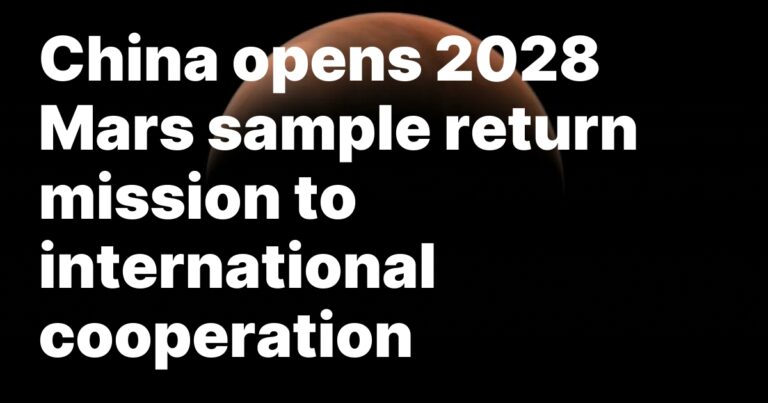HELSINKI — China is inviting interested parties to submit proposals to join the country’s pioneering Mars sample return mission, due to launch in late 2028.
The China National Space Administration (CNSA) published an announcement of opportunities March 11, officially opening the Tianwen-3 Mars mission to international cooperation.
Tianwen-3 aims to collect samples from Mars and, for the first time ever, deliver them to Earth. The primary scientific goal is the detection of potential biosignatures and answering a fundamental question: has life ever existed on Mars?
“This opportunity is open to the global community. International partners are welcome to collaborate with the TW-3 Mission at the system or payload level,” the CNSA statement reads. The call offers new insights into the mission in terms of mission scheduling and domestic payloads.
Teams can propose piggyback payloads requiring support from the Tianwen-3 spacecraft or independent scientific instruments. CNSA has made up to 15 kilograms of mass available for international collaboration projects on the mission’s Earth return orbiter (ERO) spacecraft and a further 5 kg on the Mars orbiter (MO).
Proposals must align with the mission’s overarching scientific objectives or provide complementary or extended value, with strong innovation in science and engineering.
Expressions of interest are to be submitted to CNSA by June 30, 2025. Shortlisted teams will then be invited to submit full proposals, with final selection scheduled for October. Flight models of selected payloads will need to be delivered in 2027.
The call for collaboration comes as NASA’s own Mars Sample Return program faces delays, cost overruns, and budget uncertainties, raising questions about the future of international Mars sample return efforts, as well as the possibility for wider cuts to the agency’s science and other programs.
Tianwen-3 overview
The Tianwen-3 mission will consist of two separate launches from Earth. Two Long March 5 rocket launches will carry a lander and ascent vehicle and the Mars orbiter and Earth return orbiter respectively.
Launches are scheduled for a once-every-26-months optimal Mars launch window which is due to open for a few weeks spanning late 2028 to early 2029. Samples would be delivered to Earth around 2030 or 2031.
Mars Entry, descent and landing will build on technology used for the Tianwen-1 rover landing. China has already conducted two lunar sample return missions, Chang’e-5 and Chang’e-6, and will launch the Tianwen-2 near-Earth asteroid sample return mission around May this year.
The lander spacecraft aims to collect and launch samples with the help of an ascent vehicle. The Mars orbiter will support communication and science, with the Earth return orbiter tasked with rendezvousing with the ascender in Mars orbit and returning samples to Earth.
Mission objectives are investigating potential traces of life on Mars, studying Martian geology, the planet’s internal structure, and the atmospheric circulation and escape processes, and contributing to understanding planetary habitability.
The spacecraft will carry science payloads to aid these goals, revealed by the CNSA announcement of opportunities.
The lander will carry a Mars Subsurface Penetrating Radar (MSPR) to probe subsurface layers of the Red Planet, and a Raman and Fluorescence Analyzer for Mars (RaFAM) to detect organic materials and minerals, key to astrobiology, similar in function to NASA Perseverance rover’s SHERLOC payload.
The Mars orbiter will carry the Precipitating Energetic Neutral Atom and Aurora Detector (PENAAA) payload to study atmospheric escape processes, and the Mars Orbiter Vector Magnetometer (MOVMag) designed to measure Mars’ magnetic environment.
The ERO will carry the Mid-Infrared Hyperspectral Imager (MIHI) to map Mars’ surface composition, and the Mars Martian Multispectral Camera (MMC) for capturing high-resolution imagery.
The mission may also include a helicopter and a six-legged crawling robot for collecting samples away from the landing site, according to earlier reports, though CNSA has not confirmed these technologies as part of the final mission architecture.
Landing site selection, search for biosignatures
Researchers have identified three preselected landing zones for Tianwen-3. These are Amazonis Planitia, Utopia Planitia—the area within which the Zhurong Tianwen-1 rover landed—and Chryse Planitia.
The mission science group has proposed 86 potential landing sites, according to a 2024 National Science Review paper, focusing on areas that maximize the likelihood of preserving biosignatures, such as locations with ancient deltas, lakes, and water-related landforms, while meeting engineering constraints.
Landing site constraints include an altitude of at least 3 kilometers below the global average to ensure greater atmospheric density for deceleration. Suitable latitudes range from 17° to 30°N, balancing scientific interest with engineering safety factors such as solar illumination, and surface and atmospheric conditions.
Sampling is likely to consist of both surface sampling and drilling. The former will focus on fine-grained sedimentary rocks and clay minerals, which are more likely to contain preserved organics, while the latter approach is designed to reach deeper layers, avoiding the oxidizing effects of Mars’ surface environment.
The mission is highly focused on astrobiology and will also include contamination control and planetary protection measures.
Tianwen-3 could mark a significant breakthrough both scientifically and for China’s space leadership. If successful, Tianwen-3 would establish China as a leader in planetary exploration. The returned samples could be the key to answering one of the most profound scientific questions—whether life ever existed on Mars.

